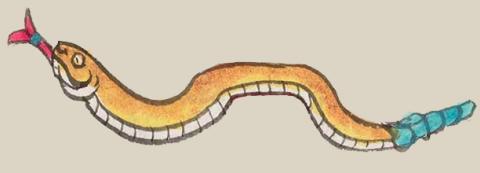coatl (Mdz8r)
This element for a serpent or snake (coatl) has been carved from sign for the place name, Chontal Coatlan. This snake is shown in full body, curving or undulating, and perhaps moving toward the viewer's left. Its tongue is red and bifurcated. Its rattles is turquoise, and its body is brown changing to yellow, and it has a white, segmented belly.
Stephanie Wood
The use of turquoise blue on the tail seems to suggest preciosity. The appearance of the serpent's tongue recalls the glyph for (tletl) (fire or flame) (see below, right). Perhaps the snake's bite caused awe, much as fire did. Serpents did have an association with fire and the fire divinity, Xiuhtecuhtli, as explained by Esther Pasztory (paraphrased by Ian Mursell). The presence of rattles is also important, even if artists often omitted them, because rattlesnakes ware significant in Mesoamerican cultures, as the study of rattlesnakes by Ian Mursell of Mexicolore also elaborates. A wooden, turquoise-mosaic pectoral in the shape of a snake is held in the British Museum, whose curators have written: "The Mexica considered serpents to be powerful, multifaceted creatures that could bridge the spheres (the underworld, water and sky) owing to their physical and mythical characteristics." Besides being an animal that was common in the central highlands, the coatl is the name of the first day of a thirteen-day calendrical cycle.
Stephanie Wood
Stephanie Wood
c. 1541, but by 1553 at the latest
Stephanie Wood
víboras, culebras, serpientes, cohuatl, crótalos, ondulante
coatl. This is a wooden votive object found in the excavations of the Templo Mayor. Photograph by Robert Haskett, Museo del Tempo Mayor, 15 February 2023.

coa(tl), snake or serpent, https://nahuatl.wired-humanities.org/content/coatl
Mexico City
el serpiente, la culebra
Stephanie Wood
Codex Mendoza, folio 8 recto, https://digital.bodleian.ox.ac.uk/objects/2fea788e-2aa2-4f08-b6d9-648c00..., image 26, of 188.
The Bodleian Libraries, University of Oxford, hold the original manuscript, the MS. Arch. Selden. A. 1. This image is published here under the UK Creative Commons, “Attribution-NonCommercial-ShareAlike 3.0 License” (CC-BY-NC-SA 3.0).

